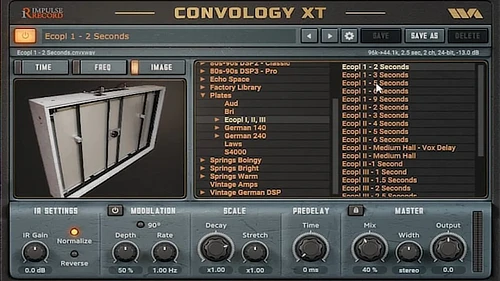The Kurzweil KSP8 is a high-performance, multi-bus, 8-channel effects processor designed for professional engineers, producers, and musicians looking for exceptional sound quality and extensive real-time control. It offers more than double the processing power of the KDFX effects system found in the renowned Kurzweil K2600 synthesiser.
With enhanced processing capabilities, the Kurzweil KSP8 builds on the KDFX’s foundation by incorporating new surround reverbs and various stereo and mono algorithms. Its flexible architecture allows for simultaneous processing of up to 8 channels in mono, stereo, or surround configurations. Unlike other high-end effects units with limited DSP allocations, the KSP8’s 16 processing units can be freely distributed across up to 8 effect buses.
The Kurzweil KSP8 delivers top-tier audio quality, boasting industry-leading analogue specifications and unique output circuitry. Its power and flexibility make it an essential tool for professional studios, semi-pro setups, and sound designers seeking to explore new sonic landscapes.
The system’s architecture is straightforward and intuitive. At its core are effect algorithms, meticulously designed for mono, stereo, and surround applications, with extensive parameters for customisation. From these, Kurzweil’s engineers have crafted a wide range of effect presets—from lush and expansive to bold and dynamic.
Effect presets can be linked together across up to 8 buses, with extensive options for customisation. MIDI and other local modulation sources, including 36 LFOs and 36 envelope generators, allow for deep manipulation and automation, with 72 functions available to combine control sources.
At the top level of the Kurzweil KSP8 architecture is the “studio,” a snapshot of the complete state of the unit. A studio setup includes all physical connection settings, signal routing (both analogue and digital I/O), signal levels, assigned effect presets, chains, effect bus assignments, MIDI settings, and multi-band EQ settings. Users can store and recall entire projects effortlessly, with up to 999 locations for user-created setups. SmartMedia cards provide an easy way to save and manage these configurations.
The Kurzweil KSP8 offers a comprehensive suite of 249 DSP algorithms, creating over 600 effect presets, including reverbs, rooms, flangers, choruses, delays, distortions, cabinet simulators, and more. Tempo-based effects like flangers, panners, and delays can be synced to an internal or external MIDI clock, with the internal system tempo adjustable via a Tap Tempo button.
The Kurzweil KSP8 is equipped for today’s audio and video production needs, supporting a variety of surround formats for DVD production. It includes unique algorithms for 5.1 surround reverb and multi-channel compression, making it ideal for enhancing 5.1 channel surround mixes in any studio environment.
The base model comes with 4 balanced analogue inputs and outputs and AES/EBU digital I/O, providing 6 possible channels. An I/O option slot allows for further expansion. The unit operates at 44.1 kHz or 48 kHz, maintaining 24-bit precision across all channels.
Its design features a user-friendly interface with a 240 x 64 backlit display, scroll knob, data entry keypad, and dedicated function buttons. Essential controls are easily accessible, while the Quick Pages feature offers instant access to frequently used parameters.
Housed in a 2U rack-mountable chassis, the Kurzweil KSP8’s design allows for future expansion through user-installable I/O option cards. These options include additional analogue channels, or digital channels in Alesis Lightpipe, Tascam TDIF, mLAN (Firewire/IEEE-1394), or AES/EBU formats.
The mLAN option offers direct FireWire connectivity, transforming the KSP8 into a comprehensive solution for digital I/O, MIDI interface, and effects processing for computer-based recording. With all expansions installed, the Kurzweil KSP8 can process up to 8 separate input signals from up to 14 sources. An additional hardware option slot is available for future growth.
As new technologies emerge, the KSP8’s operating system and ROM objects can be updated via SmartMedia or MIDI. Advanced users can also fully customise ROM objects to suit specific needs.
The optional RSP8 remote provides comprehensive control over all Kurzweil KSP8 functions. It features the same display, navigation, and data entry controls as the Kurzweil KSP8, plus a joystick and 8 knobs for enhanced control. The RSP8 can control up to 7 Kurzweil KSP8 units when used with the optional HUB7 multi-port hub, making it a powerful addition to any studio setup.
Effects Algorithms
- Reverbs (booths, rooms, chambers, halls, plates, stages and more), Delays, Choruses, Flangers, Phasers, Shapers, Enhancers, triggered Filters, Distortions, Tube Simulators, Compressors, Limiters, Expanders, Gates, Bit Resolution Degenerators, Aliasing, Ring Modulators, Cabinet Simulators, Spatializers, Rotary Speaker Emulations, Tremolo, Resonant Lowpass, Highpass Filters, Bandpass, Notch, Parametric, Graphic and Multi-band equalizers, Kurzweil¹s unique Laserverb, Pitcher’ and Chaos, plus others



